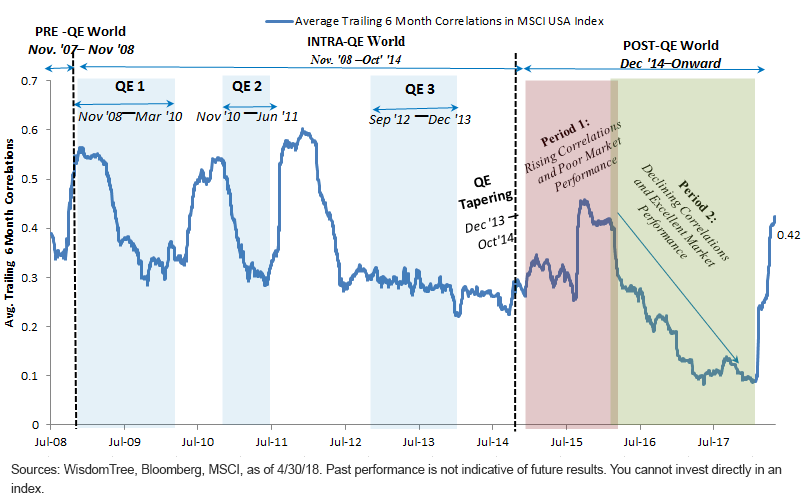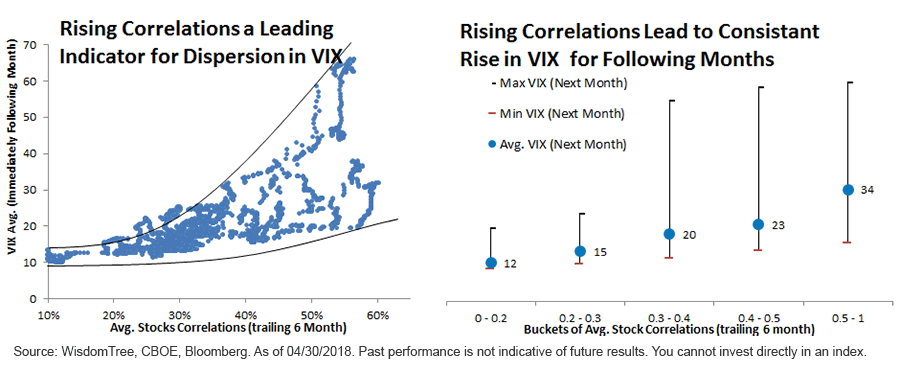Interplay of Correlations, Volatility & Positioning in Current Markets


Most experienced investors understand that lack of variability doesn’t necessarily equate to stability. In 2017 the Cboe Volatility Index (VIX) averaged around 10, which is almost half its long-term average. So far this year, VIX has averaged close to 17.5, including a massive 100% spike on February 5—a once-in-almost-200-years event on a statistical basis!1 Call it a reversal to normal standards or something else, but my analysis below shows that a higher VIX is likely here to stay for some time.
I recently covered how increasing stock correlations were a leading indicator of this spike in VIX and how our proprietary model suggested risk off in February. However, even more interesting questions remain: Is there a leading relationship between stock correlations and VIX? And if so, what does it tell me for my asset allocation?
Unusual Acceleration in Stock Correlations
Most asset allocation exercises aim for diversification, seeking a lower systematic or market risk. Typically, such diversification in normal markets can be achieved to an extent by a broad stock-selecting strategy. For instance, investing in a broad, diversified index strategy is typically better than taking a concentrated position in fewer names. Of course, diversification does not eliminate the risk of experiencing investment losses.
Now, let’s see how easy it is to achieve diversification in the current regime by analyzing stock correlations in the U.S. The exhibit below plots the average of all possible pairwise trailing six-month correlations of equities in the MSCI USA Index. As I covered in my aforementioned blog post, in a post-quantitative easing (QE) world, correlations have generally been declining. However starting in mid-January of this year, there has been a very sharp acceleration in stock correlations. Arguably, therefore, merely allocating to stocks in the current regime is posing a challenge in de-risking systematic risk.
Significant Pickup in Average Stock Correlations

Next, let us see how this has played out this year and how it has been spooking VIX as well as equity markets.
Accelerating Correlations: A Canary in a Coal Mine?
When I analyze further, it seems average correlations have a predictive power to VIX. In the left exhibit below, we again have our average pairwise stock correlations (trailing six months) across all equities in the MSCI USA Index on the x-axis and average VIX levels in the month that followed on the y-axis.

Two patterns are immediately obvious
1. Higher correlations across equities led to higher VIX levels the following month. Thus, rising correlations act as a signal of higher VIX in the future.
2. Higher correlations in equities also led to a big dispersion in VIX ranges (again in the following month).
To summarize, accelerating correlations not only act as a forerunner for spikes in VIX but also indicate potential wild swings in VIX.
Conclusion
This all leads to few conclusions:
- After years of low correlations in a post-QE world, we are now entering a regime where higher correlations are feeding higher volatility. In my view, higher volatility (compared to 2017) is here to stay.
- Increasing stock correlations within equities are additionally making it harder for investors to look for diversification by simply investing in equities. Thus, beating markets through simple stock selection is getting harder.
Therefore, strategies that seek to generate income by selling volatility (i.e., writing options), such as WisdomTree’s CBOE S&P 500 PutWrite Strategy Fund (PUTW), deserve attention. Not only can the strategy generate higher potential income if VIX were to stay elevated, but this income can offset some losses if equities were to go through a downturn, especially in a highly correlated and volatile market. Additionally, our long/short strategies, the WisdomTree Dynamic Long/Short U.S. Equity Fund (DYLS) and the WisdomTree Dynamic Bearish U.S. Equity Fund (DYB), which opportunistically hedge and seek to provide market-neutral DYLS to bearish DYB experience in markets where fundamentals are deteriorating, can help investors by providing diversifying exposure in declining markets.
Finally, irrationality of markets is hard to predict, and the above indicators should not be taken as a complete equity sell-off signal. The indicators suggest it is worth blending equities with lower-equity beta risk and market-neutral strategies. Such asset allocations may provide investors with better diversification and could defensively posture their portfolios in current volatile markets.
1Sources: CBOE, Bloomberg, as of 4/30/18.
Important Risks Related to this Article
There are risks associated with investing, including possible loss of principal. These Funds will invest in derivatives, including S&P 500 Index put options (“SPX Puts”) and a substitute to gain short exposure to equity securities. Derivative investments can be volatile, and these investments may be less liquid than securities, and more sensitive to the effects of varied economic conditions. The value of the SPX Puts in which the Fund invests is partly based on the volatility used by market participants to price such options (i.e., implied volatility). The options values are partly based on the volatility used by dealers to price such options, so increases in the implied volatility of such options will cause the value of such options to increase, which will result in a corresponding increase in the liabilities of the Fund and a decrease in the Fund’s NAV. Options may be subject to volatile swings in price influenced by changes in the value of the underlying instrument. The potential return to the Fund is limited to the amount of option premiums it receives; however, the Fund can potentially lose up to the entire strike price of each option it sells. Due to the investment strategy of the Fund, it may make higher capital gain distributions than other ETFs. Derivatives used by the Fund to offset its exposure to market volatility may not perform as intended. The Fund may engage in “short sale” transactions and will lose value if the security or instrument that is the subject of a short sale increases in value. A Fund that has exposure to one or more sectors may increase the Fund’s vulnerability to any single economic or regulatory development. This may result in greater share price volatility. The composition of the Index is heavily dependent on quantitative models and data from one or more third parties and the Index may not perform as intended. The Fund invests in the securities included in, or representative of, its Index regardless of their investment merit and the Fund does not attempt to outperform its Index or take defensive positions in declining markets. Please read each Funds’ prospectus for specific details regarding the Funds’ risk profile.


